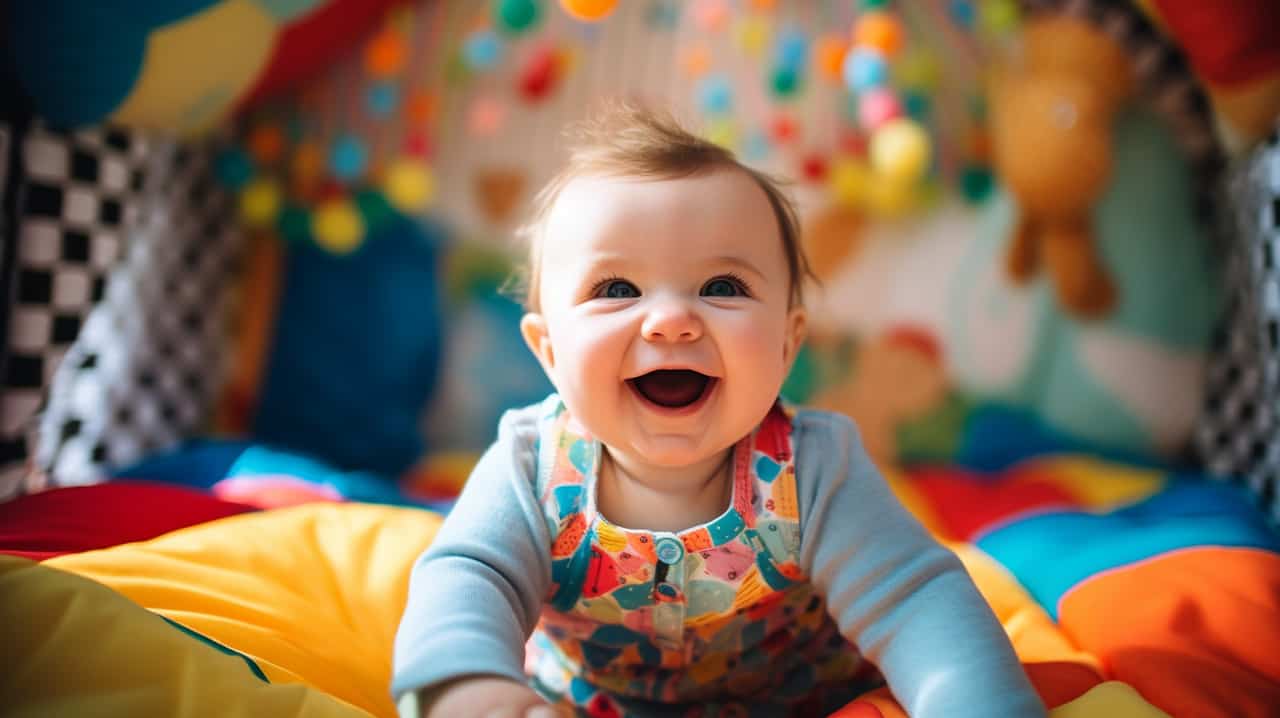Jumping into parenting can feel overwhelming, especially when deciding on baby gear like jumpers. I’ve been in your shoes and did extensive research to know when it’s safe for our little ones to start using these popular playtime accessories.
In this blog post, I’ll share my findings from pediatric experts and safety guidelines—from signs of readiness, potential risks, and benefits—all the way to alternatives and when they should stop playing with a jumper.
Ready? Let’s bounce right into it!
Key Takeaways
The ideal age to introduce a jumper toy to your baby is around six months, when they have gained enough neck control.
Before using a jumper, ensure that your baby meets the weight requirements specified by the manufacturer and that their body comfortably fits into the seat without slipping through.
It’s important to monitor your baby’s hips and legs for any signs of discomfort or strain while using a jumper, as well as prevent head injuries by creating a safe environment free from hazards.
Alternatives to jumpers include exersaucers, playpens or pack ‘n plays, baby gyms, bouncer seats, and floor time. Remember to always prioritize safety and supervise your baby during playtime.
Table of Contents
Understanding Baby Jumpers
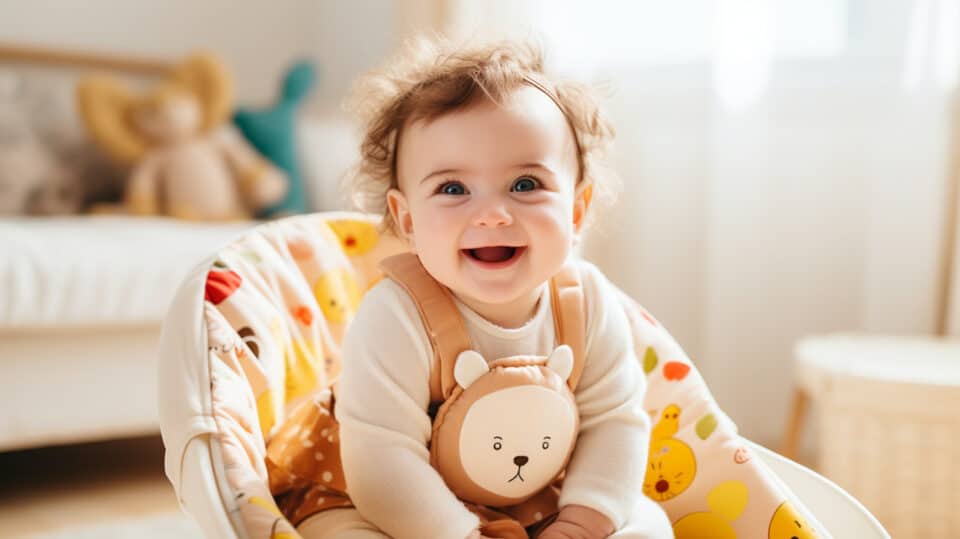
Baby jumpers, also known as bouncers or Jumperoos, bring an element of excitement to a baby’s world. They are cleverly designed pieces of equipment that allow your little one to bounce up and down while being securely held in place by restraints.
The core part is the jumper seat attached to a sling which provides motion and amusement for the baby.
Jumpers can be stationary frames with built-in toys and buttons for extra stimulation or door frame models that help enhance the baby’s leg muscles through bouncing motions. When selecting a suitable jumper, you should always check the manufacturer’s label for age restrictions and weight limits, ensuring it aligns with your child’s size.
Despite their entertainment value, Pediatric experts warn against overuse due to potential risks associated with motor development delay if used excessively. Moreover, they shouldn’t be used for sleeping because angled seats can contribute to Sudden Infant Death Syndrome (SIDS).
Always remember Baby’s safety comes first, so use these devices wisely in line with recommended guidelines.
Ideal Age for Babies to Start Using Jumpers
There’s a sweet spot for introducing jumpers to your baby, generally around six months of age. This is when most little ones have gained enough neck control—an essential prerequisite for using such toys.
I can’t stress enough how vital it is to ensure your baby has good head control before starting this journey.
As you embark on incorporating this fun activity into your routine, keep in mind that every child develops at their own pace. Some might be ready earlier, while others will take more time, and that’s perfectly okay.
It all boils down to the individual development of each little one. You know best as a mom and should trust your instincts about what’s right for your baby.
Jumpers aren’t just about bouncing fun; they’re also about safety and proper physical development. Keep in mind the weight limit specified by manufacturers—usually between 25 and 33 pounds—and phase out the jumper once your tot reaches this threshold.
Jumpers are not for nap times as well; sadly, they contribute to Sudden Infant Death Syndrome (SIDS) because of their angled position.
Signs That Your Baby Is Ready For the Jumper
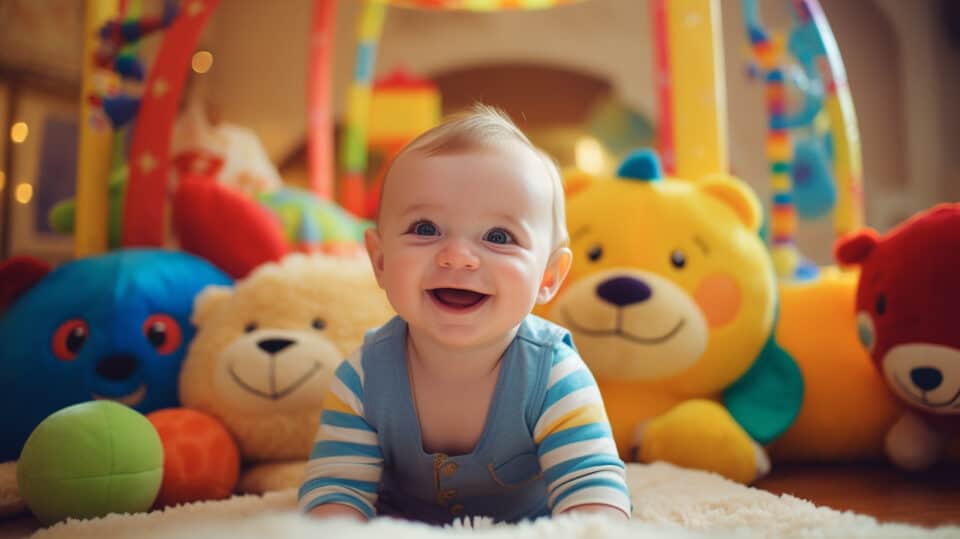
As a vigilant mother, you want to introduce your baby to new experiences at the right time. Here are the signs that your little one is ready for a fun experience with a jumper:
- Good head control: Pediatric experts often advise that babies should have good neck and head control before using a jumper. This usually develops around six months of age.
- Weight requirements: Your baby must meet the weight requirement specified on the manufacturer’s label of the jumper. Most jumpers are designed for babies weighing between 15 to 25 pounds.
- Readiness in size: Observe if your baby’s body parts, especially her legs and hips, fit comfortably into the jumper seat without slipping through.
- Interest in exploration: An important sign is when your baby becomes more curious and shows interest in his surroundings, suggesting he might enjoy exploring toys and buttons often found on jumpers.
- Regular upper body movement: Watch out for constant squirming or activity in your little one’s body, indicating she has enough energy and strength for a jumper session.
- Adequate motor skills: While using a jumper requires predominantly leg movement, it also engages general motor skills development, such as promoting balance and coordination, which should be developing adequately.
- Baby’s comfort level: As they sway their little leg muscles while on the floor or during tummy time, monitor how comfortable they seem with maintaining their own movements, which may hint at readiness for moving onto using a jumper.
Potential Risks and Safety Tips

Potential risks associated with using a baby jumper include the risk of head injury if the baby hits their head against the door frame or beam, as well as potential developmental delays if the jumper is relied on too heavily.
To ensure safety, parents should closely monitor their baby’s hips and legs for any signs of discomfort or strain while using the jumper. Additionally, it is important to follow all safety recommendations provided by pediatric experts and manufacturers to minimize any potential risks.
Monitoring Baby’s Hips and Legs
It’s important to closely monitor your baby’s hips and legs when using a jumper toy. As babies bounce up and down, their leg muscles are strengthened. However, improper positioning or prolonged use of a jumper can potentially affect the development of their hip joints.
This is why it’s crucial to ensure that the seat of the jumper provides adequate support for your baby’s hips, allowing them to maintain a natural position while bouncing. Additionally, be mindful of any signs of discomfort or strain on their legs.
If you notice any redness or swelling in their groin area, it could indicate an issue with their hip joints. Regularly check your baby’s hips and legs throughout their time in the jumper to ensure they are comfortable and safe from any potential risks or complications related to hip development.
Preventing Head Injury
One important aspect of using a baby jumper is preventing head injuries. As babies bounce and move around in the jumper, there is a risk of their heads hitting against hard surfaces or objects.
To minimize this risk, it’s crucial to ensure that the area where your baby will be using the jumper is clear of any hazards. Remove any sharp or dangerous items within reach, such as coffee tables or toys with pointed edges.
Additionally, make sure that the baby’s feet are not able to push off against anything that could cause them to tip over or hit their head. Providing a safe and cushioned space for your baby to use the jumper can help prevent head injuries and keep them happily bouncing away!
Different Types of Baby Jumpers
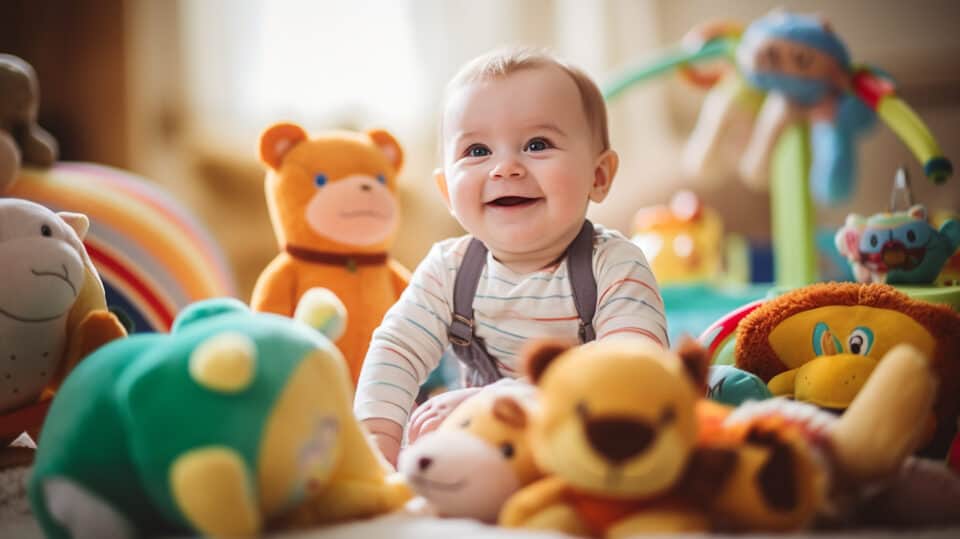
There are two main types of baby jumpers: stationary jumpers and door frame jumpers.
Stationary Jumper
I remember when I first introduced my baby to a stationary jumper. It was such an exciting milestone for both of us! Stationary jumpers are great because they provide a safe and secure space for babies to bounce, play, and explore their surroundings.
These jumpers typically consist of a seat attached to a sling that is suspended from a frame. They often come with toys and buttons to keep your little one entertained while they bounce away.
Just make sure to check the manufacturer’s label for any age or weight restrictions before using it with your baby.
Door Frame Jumper
When it comes to baby jumpers, there are different types available, including door frame jumpers. Door frame jumpers are designed to be mounted on a door frame or beam and allow babies to bounce and play.
However, it is important to note that these jumpers can pose a risk of injury if the baby hits their head or body against the frame. This is why it’s essential to closely monitor your baby while using a door frame jumper and ensure that they have good neck control before introducing them to this type of jumper.
Always prioritize your baby’s safety and follow the manufacturer’s guidelines for age restrictions and weight limits.
Benefits of Using a Baby Jumper
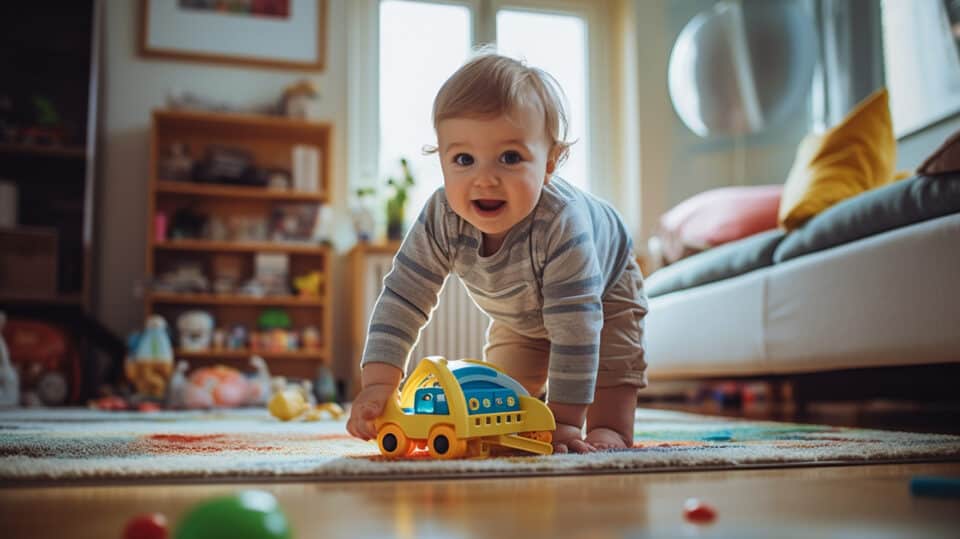
Using a baby jumper can be incredibly beneficial for both you and your little one. First and foremost, it provides your baby with a safe space to play and explore while giving you some much-needed break time.
It allows your baby to experience the joy of independent movement, strengthening their leg muscles and promoting overall physical development.
Additionally, baby jumpers provide valuable sensory stimulation through the bouncing motion, which can enhance your baby’s vestibular system and help them learn about cause and effect.
The engaging toys and buttons that often come with jumpers also provide entertainment and encourage hand-eye coordination.
Moreover, using a jumper can give your baby a change of scenery from their usual routine of playing on the floor or being held by you. This change in environment can stimulate their curiosity, engagement, and enjoyment.
It is important to note that while there are many benefits to using a baby jumper, moderation is key. Jumpers should not replace other forms of play or interaction with your little one; rather, they should complement those activities in short bursts throughout the day.
By understanding when it is safe to introduce a jumper toy to your baby and following safety recommendations such as monitoring their hips and legs during use, preventing head injuries by avoiding door frame jumpers without proper padding or protection, limiting jumping sessions based on weight restrictions specified by manufacturers), you can ensure that using a jumper will be an enjoyable experience for both you and your little one!
Alternatives to Baby Jumpers
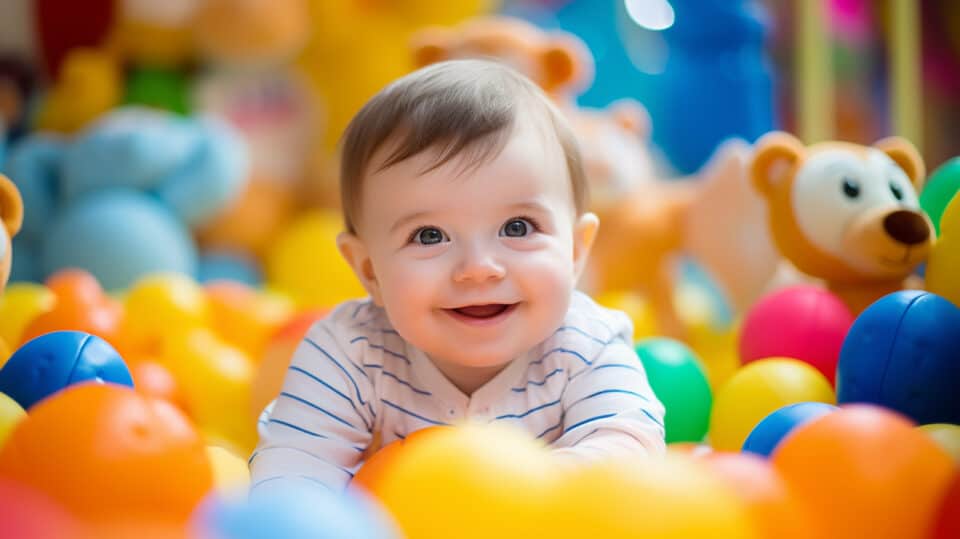
If you’re considering alternatives to a baby jumper, here are some options:
- Exersaucer: These stationary activity centers allow babies to bounce, spin, and play with toys while safely enclosed in a seat. They provide a similar level of entertainment and stimulation as jumpers.
- Playpen or Pack ‘n Play: These versatile enclosures provide a safe space for babies to explore and play. You can set up toys inside and let your baby move around freely without the need for restraints.
- Baby Gym: A baby gym is a soft mat with hanging toys that encourage your little one to reach, kick, and engage their motor skills. It’s a great option for tummy time and sensory development.
- Bouncer Seat: A bouncer seat is another alternative that provides gentle bouncing motions with the help of your baby’s movements. They are usually equipped with toys and buttons to keep your little one entertained.
- Floor Time: Simply placing your baby on the floor with age-appropriate toys allows them to explore their surroundings at their own pace. This promotes independence, strengthens muscles, and encourages movement.
When to Stop Using a Baby Jumper
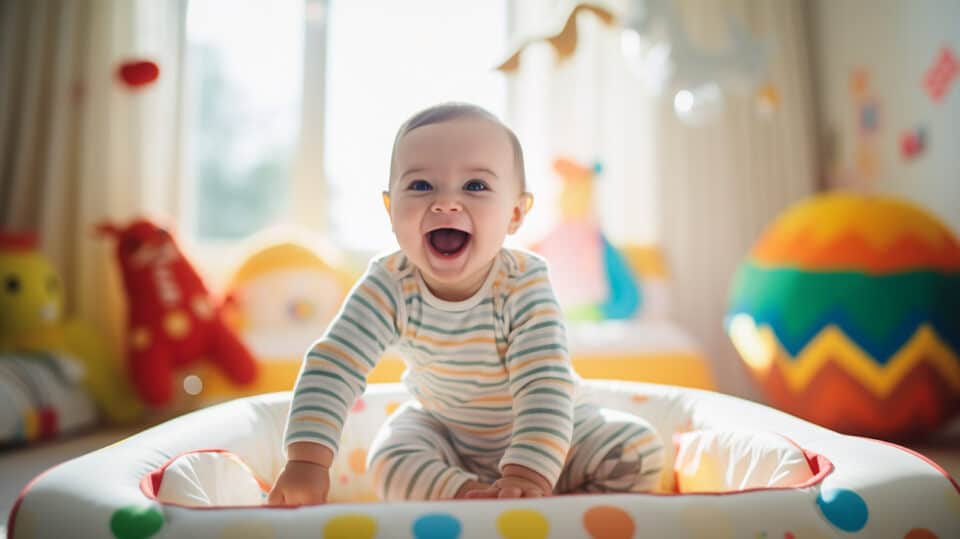
It’s essential to know when it’s time to say goodbye to the baby jumper. While jumpers can be a fun and beneficial toy for your little one, there comes a point where they outgrow their usefulness.
Typically, you should stop using a baby jumper once your little one reaches the weight limit specified by the manufacturer, which is usually between 25 and 33 pounds. Additionally, if your baby starts showing signs of discomfort or lack of interest in the jumper, it may be an indication that they’re ready to move on.
Remember, every child develops at their own pace, so paying attention to their cues and needs is crucial in determining when it’s time to retire the baby jumper.
More Frequently Asked Questions About The Correct Usage Of Jumpers
At what age can my baby safely use a jumper toy?
Babies can safely use a jumper toy when they have developed sufficient head and neck control, usually around 4 to 6 months of age.
What factors should I consider before introducing a jumper to my baby?
Before introducing a jumper toy, consider your baby’s physical development, such as their ability to hold their head up unassisted and sit with support. It is also important to follow the manufacturer’s recommended weight and height limits for the specific jumper model.
Are there any risks or safety concerns associated with using a jumper for babies?
While jumpers can provide entertainment and promote gross motor skills, there are potential risks involved. Babies should always be supervised while using a jumper to prevent accidents or injuries, such as tipping over or hitting hard surfaces. Additionally, prolonged use of jumpers may affect normal muscle development in infants.
How long should my baby use a jumper each day?
It is recommended that babies use jumpers for short periods of time, no more than 15-20 minutes per session, to prevent overstimulation and excessive strain on developing muscles and joints. Regular breaks from using the jumper are important to allow babies time for other forms of play and movement exploration.
Conclusion
In conclusion, introducing a jumper toy to your baby can be a fun and stimulating experience. However, it is important to wait until your baby has reached the appropriate age and developmental milestones before using one.
Always prioritize safety by monitoring your baby’s movements, following weight limits, and checking for safety recalls. Remember that while jumpers can provide entertainment and physical activity for your little one, they should never replace supervised playtime on the floor or other forms of interactive engagement.
